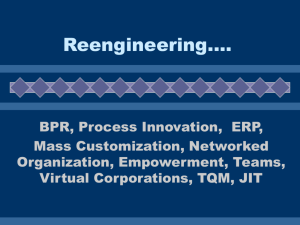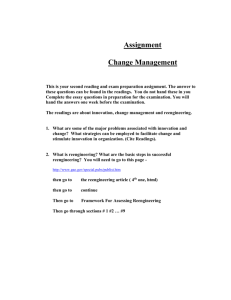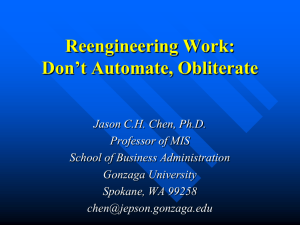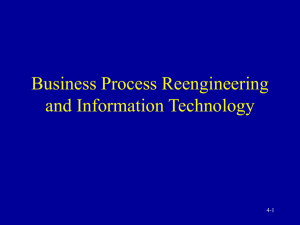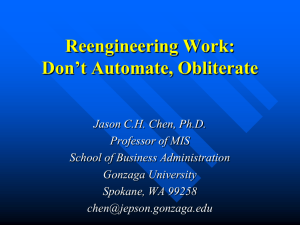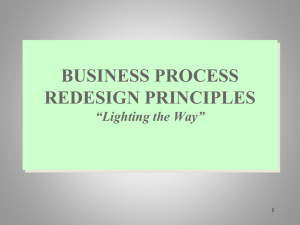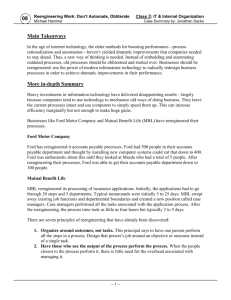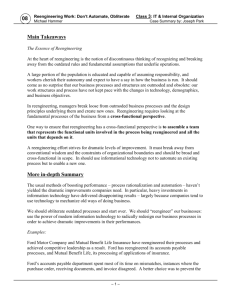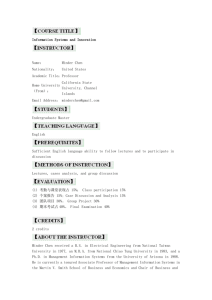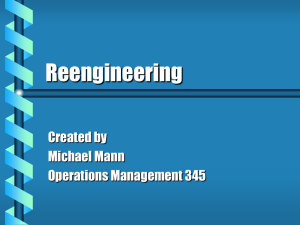Business Process Reengineering - Dr. Chao
advertisement
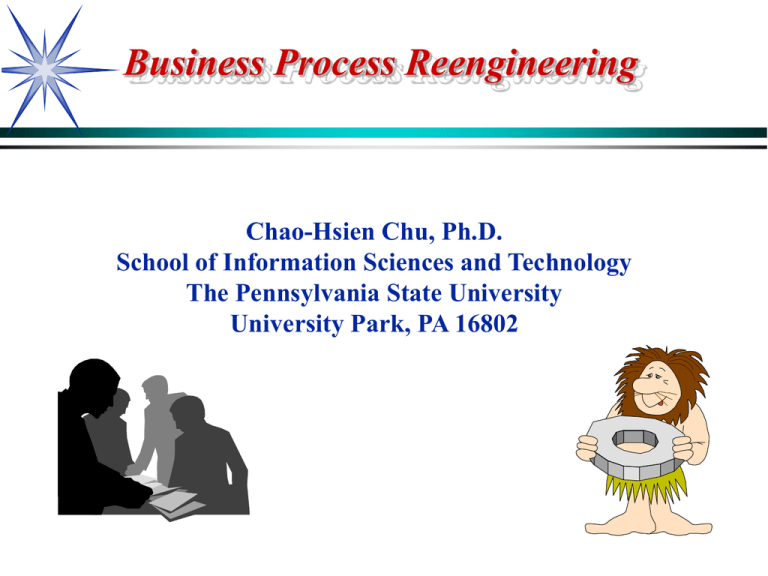
Business Process Reengineering Chao-Hsien Chu, Ph.D. School of Information Sciences and Technology The Pennsylvania State University University Park, PA 16802 BPR Theory Vs. Practice BPR Promise Fundamental change Reality 75% Failure rate Misunderstanding - What BPR is. - How to go about doing it. BPR Definition (1) Reengineering is the fundamental rethinking and radical redesign of business processes to achieve dramatic improvements in critical, contemporary measures of performance, such as cost, quality, service, and speed. Hammer and Champy 1993 BPR Definition (2) The fundamental rethinking and redesign of operating processes and organizational structure, focused on the organization’s core competencies, to achieve dramatic improvements in organizational performance. Lowenthal 1994 BPR Definition (3) Reengineering is the rapid and radical redesign of strategic, value-added business processes — and the systems, policies and organizational structures that support them — to optimize the work flows and productivity in an organization. Manganelli and Klein 1994 Processes A process is an interrelated series of activities That converts inputs into outputs. Activity Activities Value-adding Activities Important to the customer A customer is willing to pay for them Hand-off Activities Move work across functional or departmental boundaries Control Activities They control hand-off activities Process Flow CEO Marketing Customer request Operations Finance Order fulfillment Features of Business Processes Greater margin for improvement Hands-off and lost control Waste and inefficiency are difficult to detect Cross-functional problems Low percentage of value-adding activities Customers are very sensitive to poor business processes Some Business Processes Order Processing Billing Purchasing Shipping Receiving Auditing Business Planning Warranty and claims processing Budget planning Accounts payable Accounts receivable Performance appraisal Proposal development Credit approval Vendor certification New employee processing Attributes of a BPR Methodology It should develop a clear statement of corporate goals. It should be process-oriented. It should facilitate the classification of activities. It should lead to fundamental change. It should develop a plan to deliver final results within a year. Reasons for Reengineering Your continuous improvement activities have hit a dead end. The competition has grabbed your customers. You are approaching the top of the “S Curve.” Your customer’s requirements have changed. Technological advances expand the possibilities. Fundamental shifts in industry. Motivation for Redesigning BPR Improved Customer Focus Improved Cycle Time Improved Process Efficiency Building Blocks Current process review Design options Baseline analysis Design specifications Customer requirement analysis Analysis Phase Implementation Phase Transform the business High-level design Design principles Design Phase Detailed design Build in CI feedback Model and validate the new design Pilot the new design Process Selection Broken Processes: Which processes are in the deepest trouble? Important Processes: Which processes have the greatest impact on the company’s customers? Feasible Processes: Which processes are at the moment most susceptible to successful redesign? Broken Processes - Symptom Extensive information exchange, data redundancy, and rekeying Inventory, buffers, and other assets High ratio of checking and control to valueadding Rework and iteration Inadequate feedback along chains Complexity, exceptions, and special cases Important Processes Market Company Customer Issues Processes Product Cost On-time Delivery Product Features Product Design Order Processing Procurement Feasible Processes Process Scope Project Cost Reengineering Effort Owner Commitment Team Strength Common Themes Use reengineering to grow the business. Service the customer: Competing with quality of products and services. Increase revenue instead of simply cutting back through cost reduction and downsizing. Reengineering Cast Members Executive Sponsor Project Team Analysis (2-4 months) Operations research teams Benchmarking teams Voice of the client data collection teams Design (3-6 months) Workflow design teams Application design teams Pilot teams Implementation (12-24 months) Implementation teams Transition teams Understanding and Rethinking Business Processes Understand the Customer Understand the Process Benchmarking Understanding The Customer What are the customers’ real requirements? What do they say they want and what do they really need? What problems do they have? What processes do they perform with the output? Understanding Processes Why does this particular process need to exist versus some alternative solution or no process at all? Why does the process require this much time to achieve certain results? Why is the process organized this way? What aspects of the process are truly important to the customer? Revisiting Process Activities Process No Value Added Real Value Added Business Value Added Process Evaluation and Analysis Existing Process Measures of Performance Activity-Based Costing The Technology Trap “Do not automate something that should not have been done manually.” Some Characteristics of Reengineered Processes Several jobs are combined into one Case worker Case team Workers make decisions The steps in the process are performed in a natural order Processes have multiple versions Some Characteristics of Reengineered Processes Work is performed where it makes more sense Checks and controls are reduced Reconciliation is minimized A case manager provides a single point of contact Hybrid centralized/decentralized operations are prevalent Ways to Structure the Organization Flattening Organizational Structures Team Design: Baseball, Football, and Tennis Doubles Job Design: Generalists Vs. Specialists Compensation Schemes: Paying for performance and/or business results. Primary Roadblocks Failure to develop the necessary leadership. Not helping people to think in terms of business processes. Neglecting to align measures and rewards with the new business process thinking. Most Common Errors (1) Trying to fix the process instead of changing it Don’t focus on business processes Ignore everything except process redesign Neglect people’s values and beliefs Be willing to settle for minor results Quit too early Most Common Errors (2) Assign someone who does not understand reengineering to lead the effort. Skimp on the resources devoted to reengineering. Bury reengineering in the middle of the corporate agenda. Dissipate energy across a great many reengineering projects. Most Common Errors (3) Attempt to reengineer when the CEO is two years from retirement. Fail to distinguish reengineering from other business improvement programs. Concentrate exclusively on design. Try to make reengineering happen without making anybody unhappy. Most Common Errors (4) Pull back when people resist making reengineering changes. Drag the effort out. Try to make reengineering happen from the bottom up.

